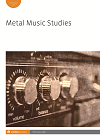
Full text loading...

Despite being one of the oldest and largest metal nations, little research on metal music from Germany exists. This article focuses on the formation of the West German power metal scene. This subgenre was one of the first to be played in Germany, and bands such as Helloween, Running Wild, Gamma Ray and Blind Guardian produced a characteristic German sound that was to become famous worldwide. Based on interviews with music producers, musicians, journalists and academics, this study analyses stylistic musical features of (German) power metal, the artists’ influences and their different aspirations for international success. The findings suggest that a characteristic German power metal sound emerged in the 1980s and 1990s that might be called ‘Teutonic’. Germany was amongst the first countries to burst out countless successful power metal bands before the genre spread to other parts of the world. No standards existed in those days, and production resources were limited and individual. This restricted infrastructure – the unique characteristics of a few recording studios along with the small circle of professional musicians, engineers and producers – has shaped the classic German power metal sound. With standardization of production resources, new techniques and consequences of globalization such as internationally operating record labels, American culture in public media and increased English language skills, these national characteristics gradually diminished.

Article metrics loading...

Full text loading...
References


Data & Media loading...

Publication Date:
https://doi.org/10.1386/mms.5.2.201_1 Published content will be available immediately after check-out or when it is released in case of a pre-order. Please make sure to be logged in to see all available purchase options.